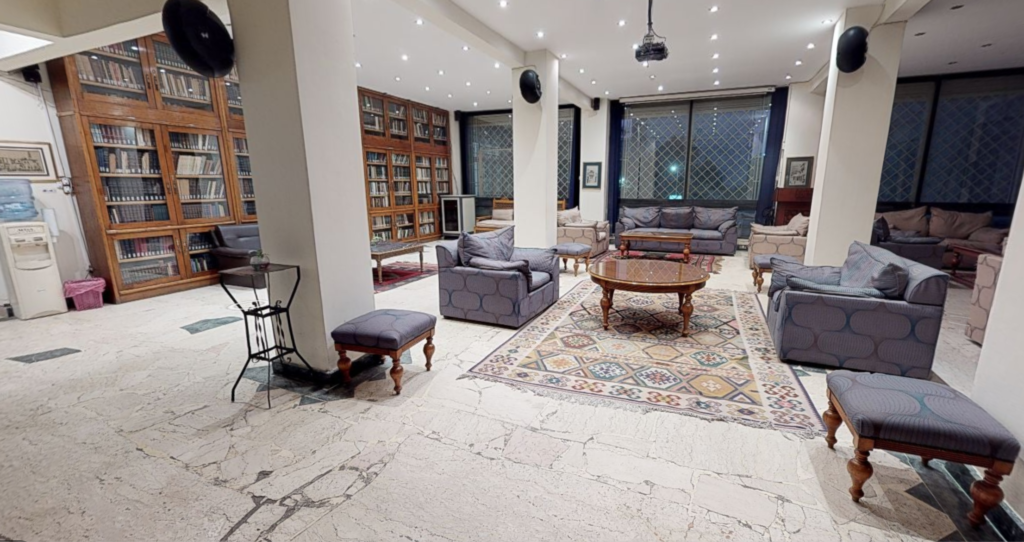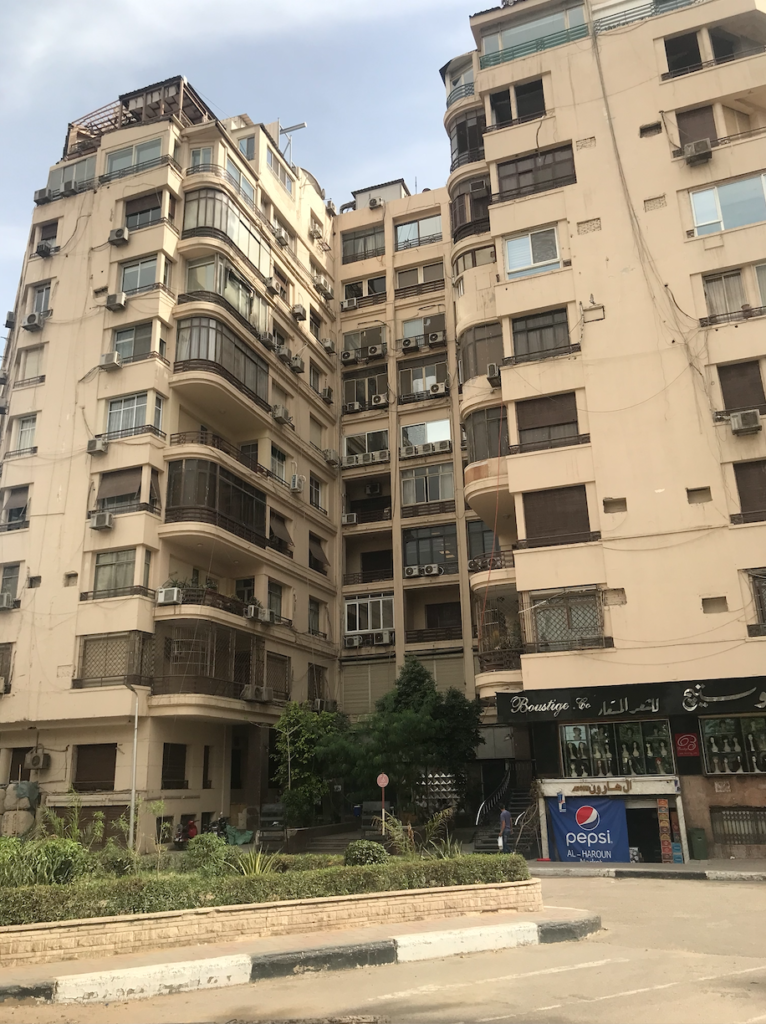By Natalya Stanke, Tessa Litecky, and Elisabeth Koch
Hazine recognizes that most archives and libraries are closed right now and emphasize prioritizing during these times the health and safety of all those who work at archives and libraries as well as the health and safety of those who use archives and libraries. We are publishing archive reviews in the hopes that eventually these repositories will be accessible again.

Just a block south of Tahrir Square in the heart of Cairo lies the American Research Center in Egypt (ARCE). Since 1948, ARCE has served as a powerful force for conservation, education, and historical research within Egypt. The archive and library collections cover 7,000 years of Egyptian history, including prehistoric Pharaonic, Coptic, Islamic, and more contemporary materials. ARCE’s conservation efforts are housed within the ARCE Conservation Archive, which serves as a resource for researchers interested in the dynamics of preserving Egyptian cultural heritage.
History

Andreas Kostopoulos)
Beginning in the early 1990s with support from the United States Agency for International Development (USAID), ARCE engaged in vital conservation work throughout Egypt leading to a unique collection of over 80 conservation projects that constitute the ARCE Conservation Archive. This collection of conservation projects are separate from ARCE’s Marilyn M. and William Kelly Simpson Library, falling instead within the ARCE Archives division.
Within the Conservation Archive, the projects span numerous archaeological and cultural heritage sites throughout Egypt. Primarily implemented with USAID grant funding, projects began in the early 1990s and continued until the latest project’s completion in 2018. To learn more about ARCE’s fieldwork conservation, visit our site or plan a visit to see the collection.
Collection
The collection consists of 88 conservation projects, each containing photographic and written material. The conservation sites cover a wide range of Egyptian history spanning over 7,000 years. Geographically and historically diverse, the projects include Pharaonic, Coptic, Islamic, and other Egyptian cultural heritage sites. Some examples include Theban tombs TT50, TT69, and TT110, and TT120, the Roman wall paintings at Luxor Temple, The Red Monastery, and Bab Zuwayla. Project work includes training, structural preservation, wall paintings conservation, and historical and archaeological documentation.
The collection contains photographic 35mm and 120mm color and black & white slides, born-digital images, technical reports and various grant-related documentation, in addition to a select number of project artifacts and architectural drawings. There are around 100,000 photographic slides, 200,000 images, 1,200 documents, 1000 drawings, as well as a small selection of artifacts and multimedia content.
Physical materials are assigned an alphabetic and numeric combination which corresponds to the appropriate grant project identifier. Materials are then organized by this grant identifier and material format in our Archives space located in the ARCE Cairo Office.
The ARCE offices –including the Archives– can be explored through a 3D scan here.
Researcher Experience
The Conservation Archive is housed in the ARCE Cairo Office within our Archives room. All materials are freely accessible in person through an appointment or through consultation with the Archives staff. Scheduling an appointment with the Archives staff is the best way to plan a visit. To schedule an appointment, email archives@arce.org.

All materials in the Conservation Archive are available for free, and ARCE membership status does not impact researcher access to material.
Although a finding aid is not currently available for researchers, all collection materials are documented through an internal database system and location of specific projects can be managed through consultation with the Archives staff.
Digital access to the ARCE Conservation Archive is a top priority for the ARCE Archives team. Digital publication efforts are currently underway for the Conservation Archive, and ARCE looks forward to sharing more information regarding digital access to ARCE materials in the near future.
The Archive is open during working hours, 8:30AM – 4:30PM on Sunday through Thursday. The Archive is closed for weekends (Fridays and Saturdays) as well as all official American and Egyptian holidays. Ramadan may also affect working hours.
Rights & Reproductions
All Conservation Archive material and copyright belongs to ARCE and USAID but is freely available for public research under the Attribution-NonCommercial-ShareAlike 4.0 International (CC BY-NC-SA 4.0) Creative Commons license. Anyone wishing to reproduce collection materials for commercial purposes must request reproduction permission as copyright restrictions apply. To request reproductions or find out more about our information usage policies, please email archives@arce.org.
An ARCE Archives website is underway, so stay tuned for more information regarding the digital publication of the Conservation Archive. Follow us on Facebook, Instagram, and Twitter @arcenational for updates.
Location and Food
ARCE is located one block south of Tahrir Square on Símon Bolívar Square in the Garden City neighborhood of Cairo, located just off of Abd el-Qader Hamza Street. The closest metro stop is Sadat station. If coming from the metro, take the Qasr al Nil exit. The building is U-shaped and faces the Abu Dhabi Islamic Bank (ADIB) and the InterContinental Cairo Semiramis Hotel. When facing the building from Símon Bolívar Square, enter through the right side and ARCE is located on the first floor. Upon arrival, ring the doorbell and wait for reception to greet and assist.

Andreas Kostopoulos)
A note on accessibility: The building contains an elevator, however there are approximately ten staggered outdoor steps that researchers must take to reach the elevator.
Should researchers wish to plan a meal to accompany a visit to the ARCE Archives, there are numerous restaurants and cafes located within the Garden City district and neighboring downtown area that fit within a wide range of budget options. Archives staff can provide suggestions upon request
Contact & Access Information
American Research Center in Egypt (Cairo Office)
2 Midan Símon Bolívar (Qasr al-Dubara)
Garden City
Cairo 11461 Egypt
Email: archives@arce.org
Phone: +20 2 2794-8239
Hours: 8:30AM-4:30PM Sunday-Thursday
Natalya Stanke works for the ARCE archives and for The American University in Cairo’s Rare Books and Special Collections Library.
Tessa Litecky is completing her MA in Egyptology at The American University in Cairo and has worked as a project assistant in the ARCE archives since February 2019.
Elisabeth Koch finished her Master’s degree in Egyptology at Freie Universität Berlin in early 2019 and started working for the German Archaeological Institute in Cairo. That summer, she joined the ARCE archives team as a volunteer.
